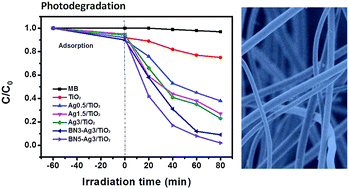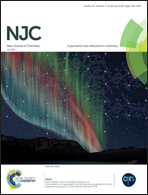High photodegradation and antibacterial activity of BN–Ag/TiO2 composite nanofibers under visible light†
Abstract
To develop material with good photocatalytic properties for organic compound degradation and bacterial removal, we produced Ag/TiO2 and BN–Ag/TiO2 composite nanofibers that included controlled amounts of boron nitride (BN) nanosheets and silver (Ag). After annealing at 500 °C under air, we used scanning electron microscopy, transmission electron microscopy, Brunauer–Emmet–Teller analysis, X-ray diffraction, energy-dispersive X-ray spectroscopy, Raman spectroscopy, UV-visible reflectance spectroscopy and room temperature photoluminescence to investigate the morphological, structural and optical properties of all samples. The photocatalytic tests using methylene blue under visible light, in repeated and long-term applications, showed that the photodegradation activity of BN(5 wt%)–Ag(3 wt%)/TiO2 composite nanofibers was 17.2 and 2.3 times higher than that of pure TiO2 and Ag(3 wt%)/TiO2 nanofibers, respectively. In antibacterial tests using Gram-negative Escherichia coli, 3 hours of incubation with BN(5 wt%)–Ag(3 wt%)/TiO2 composite nanofibers killed all bacteria. These results indicate that the synthesized BN(5 wt%)–Ag(3 wt%)/TiO2 composite nanofibers can be considered to be a multifunctional material for photodegradation and antibacterial applications.



 Please wait while we load your content...
Please wait while we load your content...